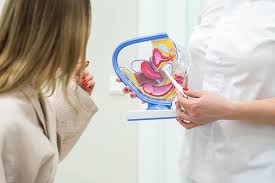A tilted uterus is neither a disease nor a pathology, it is simply an abnormal position of the uterus, which can have consequences, especially for sex life. Women with a tilted uterus often experience pain during intercourse and during the menstrual cycle. Sometimes the uterus looks this way from birth, and sometimes it takes this position after medical procedures, pathologies, or due to age-related changes. Finally, it is still widely believed that an inverted uterus can cause infertility.
In this article we will take a closer look at the features of the above-mentioned condition. “Bend” indicates that the organ, instead of being tilted forward (normally), is tilted backward, towards the rectum and spinal column.
What are the causes of a bent uterus?
This abnormal condition can be either congenital or acquired. According to statistical estimates, it affects a total of about 25% of the female population.
The causes of acquired bending of the uterus can be:
• myoma;
• endometriosis ;
• obstetric and gynecological manipulations (abortion);
• weakening of the pelvic floor muscles after childbirth.
Pelvic inflammatory diseases (PID), as well as excessive thinness, which is fraught with sagging organs and changes in the position of the uterus, can play a certain role in the development of deviations from the norm.
How does the bend of the uterus manifest itself?
Often the symptoms relate specifically to the sexual aspect of a woman’s life. Pain occurs during penetrative intercourse. This is because the backward position causes an impact on the wall of the uterus. Increased menstrual pain, especially in the lumbar region, is explained by difficult blood flow
If the uterus is malpositioned due to fibroids, it can cause difficulty urinating if it is pressing on the bladder, or bowel problems if it is pressing on the rectum.
Is a tilted uterus a cause of infertility?
This is one of the most common questions related to the fact that the uterus is the organ in which the fetus grows. But the bending of the uterus has nothing to do with infertility or spontaneous abortion. Or rather, the incorrect location of the organ does not affect the chances of conception. After all, very often it is childbirth that returns the uterus to its original place. So an inverted uterus not only does not cause infertility, but does not even prevent childbirth.
If the cause of a bent uterus is, for example, the presence of fibroids or endometriosis , then these pathologies can affect fertility, making conception difficult.
How to help with a bent uterus?
Typically, a uterine flexion does not require treatment as it is not a potentially dangerous condition. However, it can sometimes cause severe distress in the form of menstrual cramps or during sex. In the first case, specialists from the Bogolyuby MC recommend analgesics, and in the second, the couple must decide on the preferred positions in which the depth of penetration is limited.
In case of endometriosis or the presence of fibroids as the causes of uterine bending, the solution to the problem is more complex and requires an integrated approach, possibly surgical intervention.
Is it possible to change the position of an inverted uterus?
In the past, it was believed that the cause of infertility was an inverted uterus, and surgery was performed to return it to its physiological position. This is hysteropexy , very common in the 20th century and rarely used today. Intervention is justified only in cases where the inverted uterus causes severe back pain or intestinal and urinary tract disorders.



















